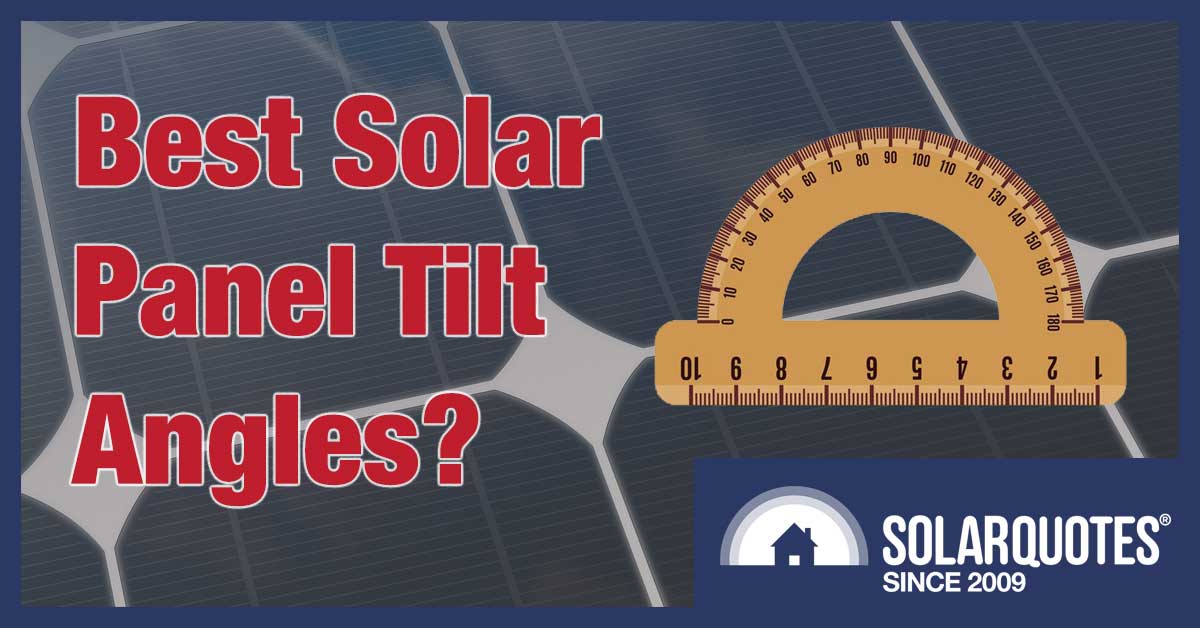
This article is about the best angle to tilt solar panels for the maximum possible energy yield over a year. It’s a common belief that panel tilt from horizontal should equal a location’s latitude, but this is not quite correct. In 7 of Australia’s 8 capitals the best angle is at least 3 degrees less than the latitude.
If you are looking to install a typical solar power system on a normal sloped roof this information may not be much use to you. While tilt frames on a sloped roof can slightly improve output, they’re normally not worth the extra expense.1 But if you are installing ground mounted solar or putting panels in tilt frames on a flat roof, the best tilt to maximise energy yield will be useful.

Note this is about tilting solar panels. Tilting windmills is a bad idea.
Best Tilt Angle Is Not Equal To Latitude
The further from the equator a place is, the higher its latitude. Darwin is pretty close to the global waistline, so its latitude is only 12º while Hobart is almost halfway to the south pole and has a latitude of 43º.
Solar panels tilted at an angle equal to the latitude will face exactly midway between the sun’s highest point in the sky in summer and its lowest point in winter.2 This seems like a reasonable way to maximise solar electricity output, but because days are longer in summer it usually helps to tilt them a few degrees lower to take advantage of this. Seasonal differences in average cloud cover can also alter the optimal angle.
Optimal Solar Panel Tilts For Capitals
I have used the PVWatts site to determine the optimal tilt for north facing solar panels in each capital for maximum annual output. While there is a small risk the PVWatts figures are off, I trust them to be accurate:
- Adelaide — latitude 35º : Optimal tilt 29º
- Brisbane — latitude 27º : Optimal tilt 24º
- Canberra — latitude 35º : Optimal tilt 30º
- Darwin — latitude 12º : Optimal tilt 18º
- Hobart — latitude 43º : Optimal tilt 37º
- Melbourne — latitude 38º : Optimal tilt 32º
- Perth — latitude 32º : Optimal tilt 28º
- Sydney — latitude 34º : Optimal tilt 31º
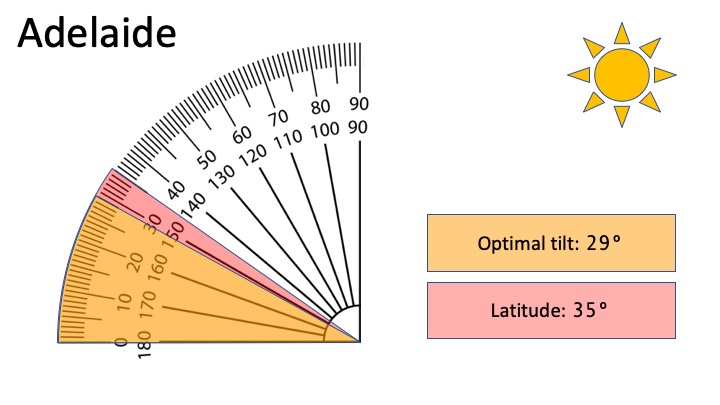
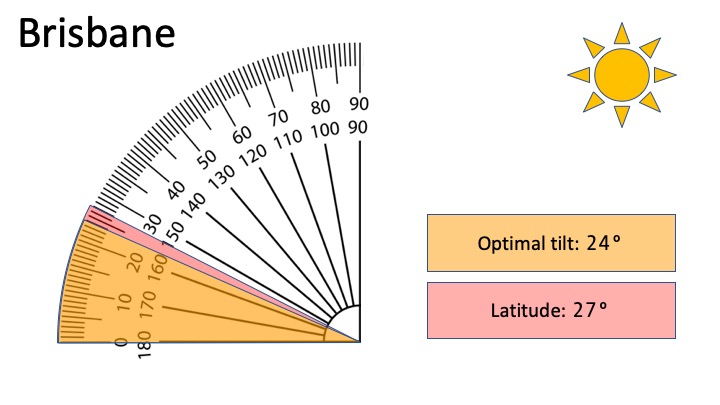
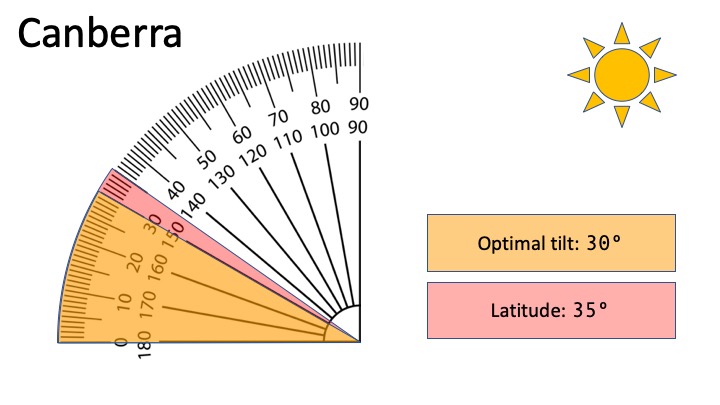
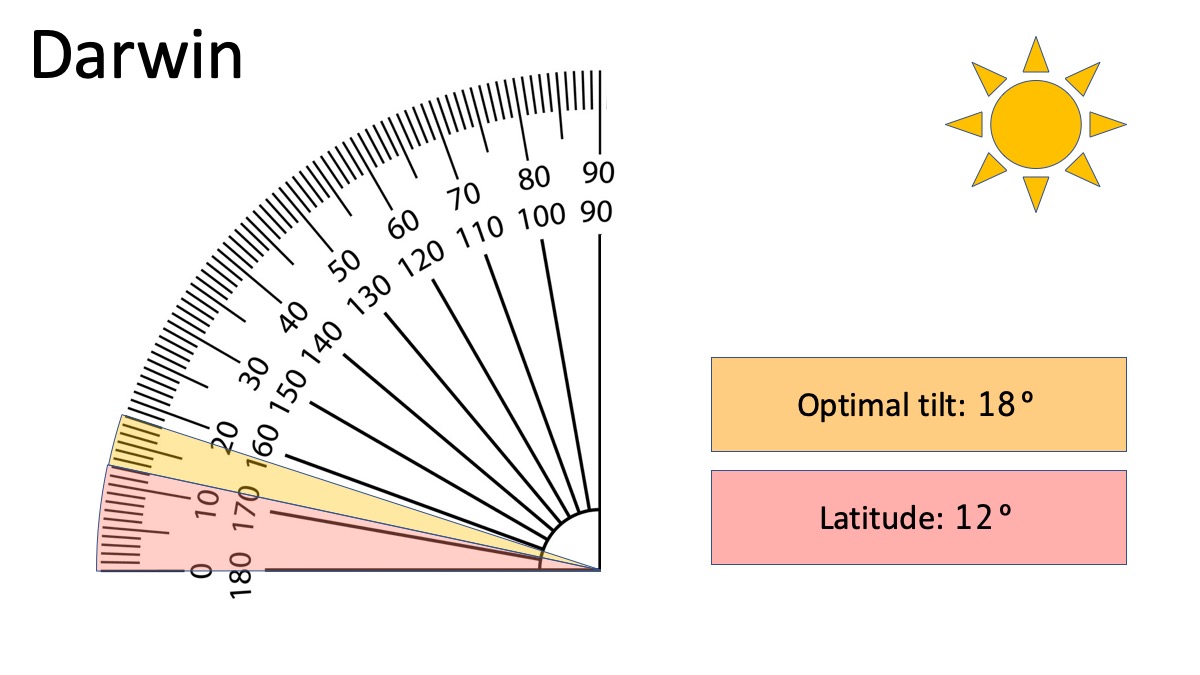
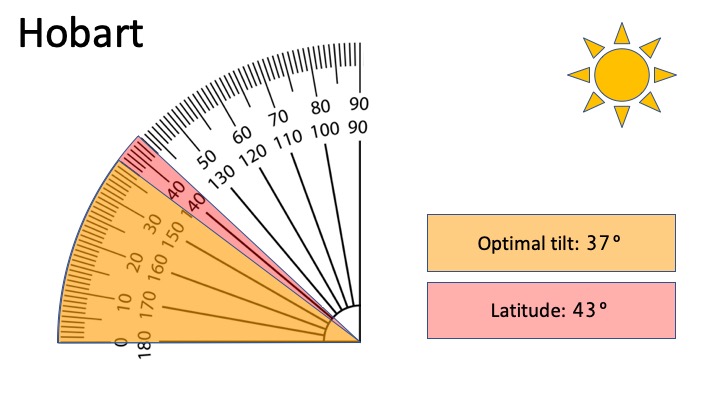
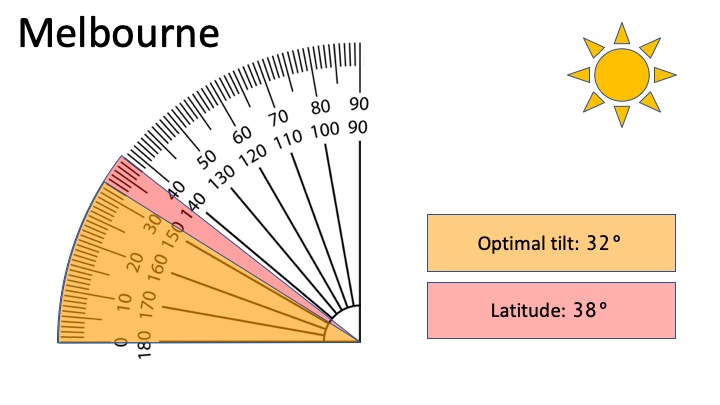
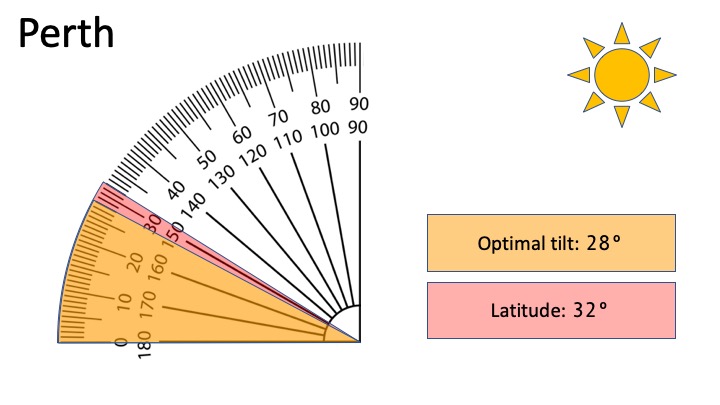
In every capital except Darwin output is maximized when the solar panel tilt is at least a few degrees less than the latitude. Darwin is the odd one out because in the far north there is little difference in the length of days between summer and winter and, thanks to clouds during the summer wet season, winter months are considerably better for solar power.
Not Much Benefit
The advantage from using the optimal tilt compared to using the latitude isn’t much. It ranges from next to nothing in Brisbane to only half a percent more in Hobart:
- Adelaide 0.37%
- Brisbane 0.07%
- Canberra 0.29%
- Darwin 0.45%
- Hobart 0.50%
- Melbourne 0.44%
- Perth 0.16%
- Sydney 0.11%
While there is an advantage to getting the tilt right, it’s not large and if the frames you are using won’t allow the exact angle you want there’s no real need to be upset about it.
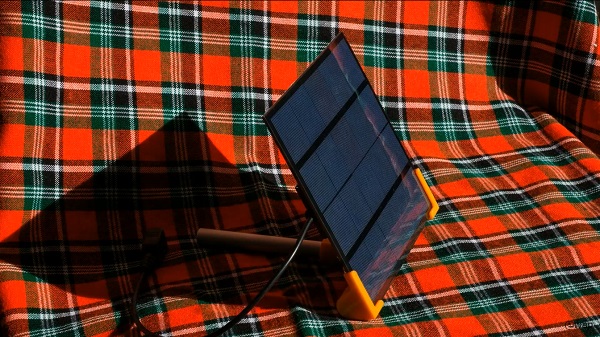
Here we see a solar cell tilt on a kilt. (Image: Daniel Aeschlimann)
Optimal Orientation Plus Optimal Tilt
Two weeks ago I wrote an article about the best direction — or orientation — to face solar panels for maximum annual output in each Australian capital city. Using these orientations has little or no effect on the optimal tilt. It will increase it by 1 degree in Adelaide and Hobart and 2 degrees in Darwin, with no change in other capitals. I’ve listed the optimal panel orientation (clockwise from north) and optimal tilt for each capital below:
- Adelaide: Orientation 6º, Tilt 30º
- Brisbane: Orientation 357º, Tilt 24º
- Canberra: Orientation 356º, Tilt 30º
- Darwin: Orientation 30º, Tilt 20º
- Hobart: Orientation 20º, Tilt 38º
- Melbourne: Orientation 8º, Tilt 32º
- Perth: Orientation 20º, Tilt 28º
- Sydney: Orientation 12º, Tilt 31º
Bifacial Panels And Tilt Frames
While they can maximise the energy yield of solar panels, generally the extra expense of tilt frames — both the cost of the hardware and the extra labour required for installation — means they’re usually not considered worthwhile for rooftop solar power. But one advantage is they allow the use of bifacial solar panels. These are double layers of glass that allow solar cells in the middle to use light from either direction, generating extra energy depending on how reflective the surface below them is, as this — hopefully accurate — image from LG Solar shows (the numbers show ‘extra energy’ compared to a non-bifacial panel):
As bifacial panels are coming down in price we may see a small renaissance in tilt frames. As batteries increase in popularity and homes and cars transition to become all-electric, people will want to generate more and more solar electricity locally. Bifacial solar panels on tilt frames will enable roof owners to maximise the energy they can generate from their precious and limited roof space.
Footnotes
- Also, your local council may not allow them. Your solar installer should know if they are permitted in your area. ↩
- Some people think it’s actually the earth doing the moving and not the sun, but Pope Urban the VIII thought that idea was revolutionary. ↩

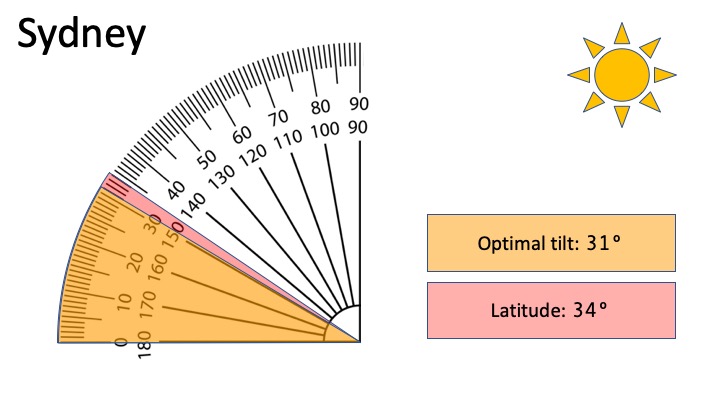
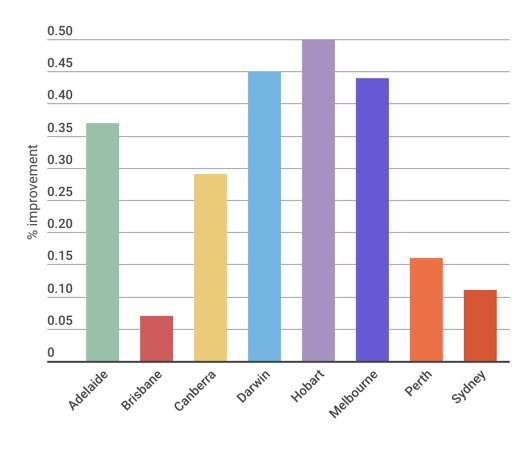
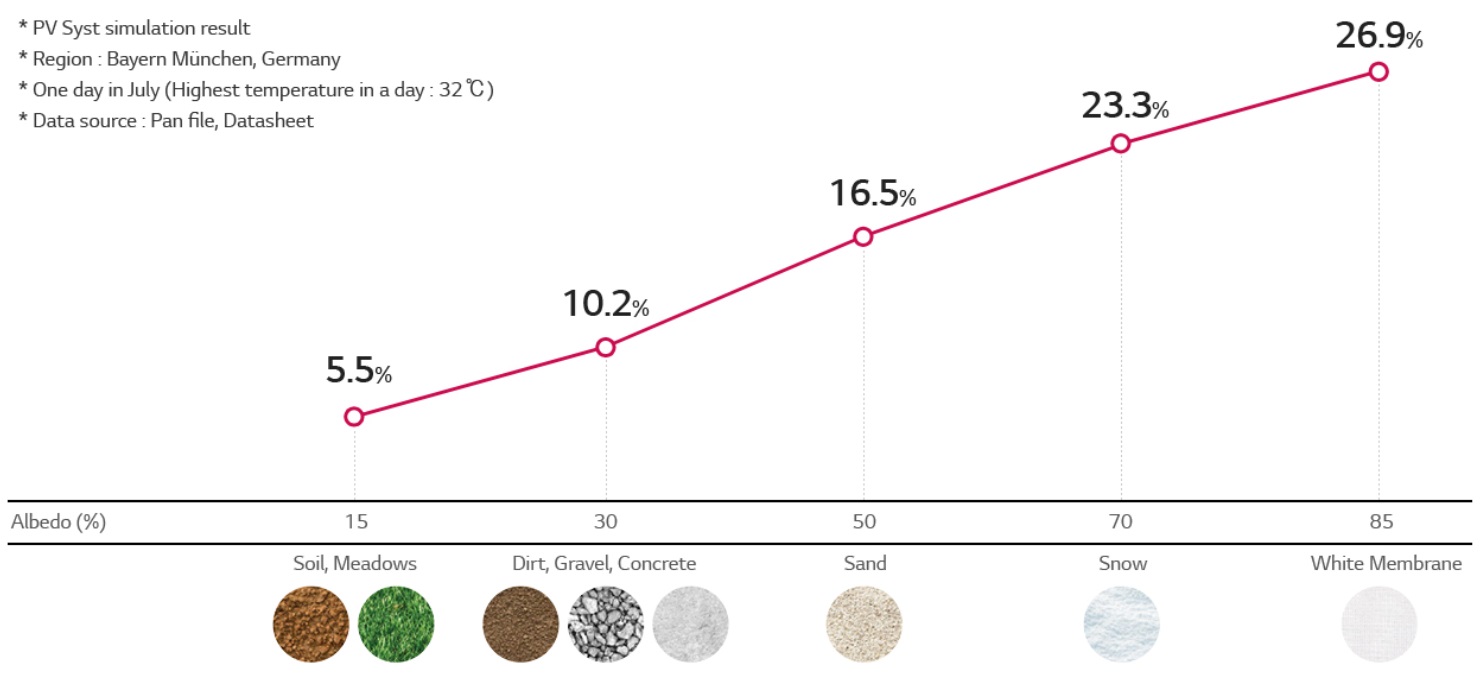
 RSS - Posts
RSS - Posts



Thanks Ronald
When we’re finished with current commitments (including a detailed look at the performance of Large-Scale Solar for our Generator Report Card) I’ll have to dig the house plans out and see how far away we are from optimal for our rooftop solar in Brisbane, which you say is:
Orientation 357º,
Tilt 24º
Will add this to the next edition of the “personal experiences with rooftop PV” here”
http://www.wattclarity.com.au/articles/2017/11/some-initial-musings-about-my-own-rooftop-solar-learning-exercise/
Paul
Hey Ron,
Showing the uplift in performance between the calculated optimum angle and the latitude angle is somewhat instructive… but unless the pitch of your roof is actually at the latitude angle (it almost certainly isn’t) then in practical terms you’re effectively comparing the benefit of frames pitched at two different angles.
Perhaps a comparison against common roof pitches would be even more instructive as this would effectively show the best possible impact of tilt frames vs conventional racks?
Why does some clockwise tilt increase production? Is this because there is more light earlier in the day?
A little clockwise orientation helps total output a little in most capitals because it is cooler in the morning and this helps panel efficiency. Differences in average cloud cover between morning and afternoon also affect the result.
Hi Ronald, I am just starting a ground mount in Tumby Bay SA. So I am looking at 6° orientation and 29° tilt. Another setup here has adjustable tilt for Summer Winter. This adds a bit if complexity and I am wondering if it is worth it?
Regards Clem.
Hi Clem
Acording to the PVWatts site…
https://pvwatts.nrel.gov/
…in Tumbly Bay the best direction to face the panels is 356 degrees. It also says a tilt of 26 degrees will maximize year round production. I can’t be 100% certain that is correct, but the site is pretty good. This change only makes a small difference from the figures you were planning to use.
For most people getting adjustable ground mounts won’t be worth it. It will only result in a small increase in total output. (If you fiddle around with PVWatts you can work out just how much.) You’ll have the bother of adjusting them twice a year and they can be more expensive to purchase. It would only be worthwhile if you enjoy doing that sort of thing.
But if you’re off-grid it’s a different story. In that case it can definitely be worthwhile to tilt your panels to maximize winter output. Being able to adjust them to increase output in summer is less important, as they will normally produce plenty of energy then anyway. If your summer electricity consumption is high you may consider it worthwhile but my advice for most people would be to just install more fixed panels and don’t worry about it.
Thanks for the reply Ronald. I will be fully off grid so the tilt adjustment may be worthwhile. I have designed a 3 pole system with an area of 5m wide (3 panels) and 10m long for 9 panels. Hopefully the 27 panels will be enough. The 3 centre poles will be 2.5m high so plenty of height for a small shed for the batteries, controller, inverter and generator. This height will allow adjustment from 10° to 90° so that should cover it.
Regards Clem.
How do we measure the loss for a 22.5º roof pitch in Sydney?
Thanks
According to the PVWatts site:
https://pvwatts.nrel.gov/
Total output will only be 1% less with a 22.5 degree tilt compared to the optimal tilt.
According to nearmap.com the optimal angle is 22.5 degrees. There is a 4% difference in output against 29 degrees.
That may be the default figure since 22.5 degrees is the most common roof tilt.
22.5 degrees for Adelaide, I should mention
How about TOU pricing?
Peak grid prices occur after 2pm, how does this effect the optimal orientation.
How about the pattern of household demand?
This changes through the day and also through the year.
Tilt will maximise panel output, but what about maximising roof output?Panel spacing? On a flat roof it will need to increase to stop shadowing and therefore will decrease number of panels on a fixed size flat roof.
It would be interesting to model a roof that is 10 times the dimensions of a panel, ie no tilt would fit 10×10=100 panels tiled flat. As soon as you start tilting you would need row spacing and loose one row, ie 10% or 10 panels. At some point as you increase tilt you would loose a second row.
You are right. I read some research about testing in Germany – flat laying panels were the most optimal for flat roofs. You still need a small tilt to run water/dust away but that’s it.
The maximum possible energy is not a very good objective. Considering low FiT, the right objective for the rooftop solar should be to offset your own consumption. You don’t need to generate too much, you need to by from the grid as little as possible. Hence, start generating early enough for breakfast and continue long enough for dinner. Lower than optimal generation at noon is not important, at noon you have more energy than you can consume.
This one would be more difficult to calculate. It requires consumption model. I do suspect that tilt should be close to zero after consideration for practicality of rain/dust clean up.
That is why i have built 18650’s into a 60V (nominal) pack capable of absorbing 11KWh – using a mppt controller with a grid tie inverter on the other side. as i rent all PV cells are near ground level
Respect! Can we come over and make a video about your setup?
Tilt on a kilt. Love it!
Food For Thought:
1. In summer a lot of systems over-produce, 1.6 kW goes to waste 4 hours a day
2. In winter, Production drops to half.
Would it make sense to sacrifice some of that summer production surplus to fill the valley in the winter production?
I understand your objective to produce energy for the “Greater Good”, but at this point, our governments aren’t incentivizing this, opting for a capitalist model. Until this changes, My focus is to bringing down my personal energy bills and that means a focus on maximising self consumption.
Tim, you’ve smashed the nail, fairly. I’m off-grid, so extra summer production either has to go into the aircon, making icecubes, or charging an electric vehicle – if I had one. At 38 deg. south, I’ve tilted both the north and west skillions to 40 deg., i.e. 2 deg. _over_ latitude. That improves winter production in an attempt to compensate for the halving of insolation which you describe. (Quote from the truss manufacturer delayed by the chocolate festivities, but promised – real soon now.)
Question: Are those bifacial panels translucent, so that even panels parallel to the roof and say 20 cm up will benefit from reflection?
My steel decking roof is specified to be 77% reflective (Colourbond “Whitehaven”), so should give about a 25% improvement, according to the graph. That trumps any tilt gymnastics by a wide margin, and will be especially useful on the west end where I can only fit 9 x 60 cell panels.
They’ll also be at 40 deg., for maximum production late in the afternoon after the sun has slipped off the northern array.
It’ll be interesting to see how this works out. (At least I snuck in the roof redesign before the trusses were made.)
Hi all first ever comment so be gentle. After trying to establish what north is being referred to and still not feeling confident could anyone reassure me. It would be greatly appreciated. As I understand grid and solar north are for most purposes near enough the same and this is in fact what is referred to when giving an azimuth or bearing….or is it in fact a magnetic bearing including mag variation. Kindest regards
Paul,
“After trying to establish what north is being referred to and still not feeling confident could anyone reassure me.”
There are different types of North:
1. True North – that’s the one that is most relevant for solar-PV performance;
2. Grid North – the difference between Grid North and True North is very small;
3. Magnetic North – the horizontal angular difference between True North and Magnetic North varies with location & time; and apparently
4. Google Maps North.
https://setcompass.com/TypesofNorth.htm
See also: https://www.solarquotes.com.au/panels/direction/
If you know your location (i.e. latitude & longitude) a solar noon calculator for anywhere on Earth on any day, can assist in determining True North, and is available here: https://gml.noaa.gov/grad/solcalc/
Hi. The article refers to true north and not magnetic north.
https://en.wikipedia.org/wiki/True_north
I used the pvwatts calculator for adelaide and get less output throughout the year for having panels at 30 degrees than for 0 degrees.
How can this be I thought the 30 degrees would decrease the summer output and increase the winter output, but not so.
Can you explain
Hi Peter
I’m guessing you used the default Azimuth of 180 degrees which is due south. It needs to be set to 0 degrees for panels facing due north. I believe it used to automatically set to 0 degrees for locations in the southern hemisphere, but it no longer seems to do that. (Maybe I should let them know.)
Hello. We want tilts for our panels for a flat roof (partly because of tree litter as well as increasing production of panels) but we can’t seem to get hold of any tilts that have been certified by an engineer to meet Australian standards. Can anyone suggest where we might find tilts with these specs available? (We need them for council approval).
I wish I had read this earlier!! We just had solar installed on our flattish roof and they never recommended tilts but after installation they told me I’d have to hose them down every couple of months for dirt. I climbed up and measured the slope on the panels to be 1.8 degrees. Any suggestions on what do to? I hate the idea of climbing up to clean them all the time
Installers are required to inform people panels installed at under 10 degrees can require extra cleaning, so that was a serious breech of ethics and standards to only do it after the fact.
Because going up on the roof is dangerous, if this is possible, I’d suggest checking from the ground first if they are dirty. (If you happen to have a drone, you can use that.) Then I’d see if it was practical to hose them off from from ground. You shouldn’t hit them directly with high pressure water, but letting enough water fall on them will hopefully be enough to get them clean. You may want to spray them, wait 10 minutes to allow dirt to hopefully loosen and then hose them down again. This should be done when the panels aren’t hot, so soon after sunrise or after sunset after they’ve had some time to cool down is probably best.
Hi Anne,
Ronald’s advice is pretty spot-on. I have more slope than you on my roof, but still give the panels an odd spray early in the AM if there’s been a lot of dust around.
I’ve got good water mains pressure, and so I attempt to adjust the spray and angle in order to as much as possible replicate the effect of ‘rain’ falling on the panels. I can do most of my roof this way from ground level. Start at the top of the panels, go right across them, and then work down for the best results, as that helps clean the lower section of the panel.
DON’T use a ladder unless you really have to. If you do, make sure you have it somewhat secured to the guttering on both sides, and ideally someone at the bottom holding it for you.
It is important to let it ‘soak’ for a bit, esp with bird poo.
The same general technique works well when washing your car too.
The area immediately around and under any TV antenna can be a bit hard to get at, It’s usually at the highest point on your roof, birds love to ‘rest’ on it and survey the scene, so it tends to collect more bird poo.
When I installed my system, I deliberately left some extra clear area
under and around the existing antenna (which catered for both analog and digital), Eventually, I replaced that antenna with the far more compact digital antenna and was able to reposition that slightly as well.
For Brisbane in winter ,what is the optimal angle tilt for solar Hot water panels.
In summer we produce far more hot water than needed which is wasted as overfllow, and would like to use the electric boost less for winter by maximising the angle.
With this new angle what would be the efficiency loss in summer?
With Brisbane at 27.47 deg S, that inclination of array would be optimal at the equinoxes. Add the axial tilt of 23.44 deg to aim for the winter sun, and you have 51 degrees for a winter solstice optimum, i.e. grab all you can in the deepest darkness of winter. (If such a thing exists in sunny Queensland.)
At 51 degrees tilt, my feel for the alignment effectiveness at the equinoxes would be cos(25.47 – 51) = 90%, and at summer solstice:
cos(25.47 – 51 – 23.44) = 65.6% , if I’m counting right on my fingers.
That’s probably more than hot enough up there, I figure.
Yep, according to PVWatts 51 degrees is basically spot on for maximum winter output for north facing panels in Brisbane.
Just an observation, there in Darwin many ground mounted panels are facing North at about 18 or 20 degrees. The problem is that in out Summer, read wet season when air conditioners and cloths dryers are doing over time, the sun is shining on the back of these panels. A mate of mine is off grid and he has his panels flat or even 5 degrees to the south to get the most power when he needs it most.
When Darwin still had it’s high solar feed-in tariff equal to the per kilowatt-hour charge of grid electricity it make sense to face panels north to maximize total generation. But now that’s no longer available, facing panels south can help boost self consumption buy boosting summer output.
Its important to think longer-term. Your panels will likely be around for 30 years or so, and it does seem somewhat probable that even within just the next 2-3 years your house and solar panels might have to cope with one or more ‘extreme’ weather events,
Your installation might meet current cyclone standards for your area, but its worth noting that the severity of storms and wind gusts – even though that severity does fluctuate due to El Nino and La Nina effects – does seem to be extending further southward from Bundaberg,
I’m not suggesting that Category 5 cyclonic wind gusts of around 280 kph are going to be hitting locations between Bundaberg and Sydney within the next 2 years.or so.
Your guess is as good as mine as to what wind speeds, rainfall and hailstone levels we are likely to encounter over the next 30 years.along the Australian coastline, but overall I think there’s a case for dispensing with tilt frames altogether and simply accepting whatever the slope of your roof is, on the basis of prudence.
Having a largish semi-vertical surface of some size protruding from your roof does not seem the wisest of longer term choices for a typical household installation.
You are addressing question and I think you might have the answer. I’m at thee 47th latitude NORTH. I can only get two roof pitches: 20,5 degrees or 22.5 degrees. (4.5/12 versus 6/12). assuming 400 watt panels that are 91% efficient, what kind of overall efficiency would I have with those slopes?
You’re at 47 degrees north? That’s, like, Zürich. I think the best thing you could do is use the PVWatts site:
https://pvwatts.nrel.gov/
You can enter your location and the details of your planned solar system and it will give how many kilowatt-hours you can expect to generate over a year with a month by month break down.
Hi!
I recently had my installer finishing a job on my fairly flat roof. The sales guy talked about tilting the panels over the phone, but it wasn’t in the written quote (which I didn’t check, lazy me…) Now I have 5 panels on a 10 degree tilt facing north and 5 panels facing south on a minus(!) 10 degree tilt. For Perth – what’s my loss vs optimal tilt? Should I question the sales guy’s projecting skills?
Btw, thanks for an excellent web resource around PV systems!
//Mike
Hi Mike
The good news is, your north facing panels on a 10 degree tilt will produce 96% as much energy as if they were at the ideal angle of 28 degrees. Your south facing panels won’t do quite as well they’ll still produce 83% as much energy through the year as north facing ones at the ideal tilt. The south facing panels will produce about 4 times as much in January as they do in June. This makes them good for cooling the home in summer, but not so great for meeting winter demand.
While tilt mounts would improve the output of the south facing panels and made their output through the year a more even, they are expensive and would have added a considerable amount to the price, so there’s a good chance you’re better off without them.
Thanks Ronald for an excellent explanation, highly appreciated!
G’day all! Thanks for all your detailed information Finn, it’s a real help.
I’ve just had panels installed on two faces of my roof, the smaller face has a slight southerly pitch. The installers used quite small tilts on the southerly facing one and the panels are basically flat now – pointing directly vertical.
They are suggesting longer tilts are not ‘legal’. Is this the case? Can’t they use much longer tilts, like my neighbours have? I’m in Melbourne FYI if that has any impact on regulations.
Great question Duncan!
I am about to commit to an install and have an 8 degree South facing pitch tin roof. With 10 degree tilt legs in the quote, my system will be almost flat. I am concerned with the cleaning aspect and loss of production due to dirty panels. How much extra is it worth spending to get around a 22 degree maximum North facing set up? (Currently looking around $1000 difference between a council run scheme and the same company doing a private install with better panels and higher degree tilts on the legs). Thanks in advance.
Jim
Is the optimal orientation from true north or magnetic north?
It’s from true north. Magnetic north is just a pain. It’s moving at around 55km a year. Worse, it’s starting to conk out. It’s down 35% from 2,000 years ago. Good thing we got GPS when we did. (Unless of course, solar storms knock the satellites out because the earth’s magnetic field is weak.)
Thanks Ron, I’m designing a house south of Adelaide so looking to focus on solar orientation not only for solar power but for passive solar gain and shading. From what I have researched, Adelaide’s true north is 8 degrees east of magnetic north. So with this guide its 6 degrees east of that? Making it 14 degrees east of magnetic north?
If the figure of 8 degrees is correct, then 14 degrees east of magnetic north would be best. But, as explained here:
https://www.solarquotes.com.au/blog/best-solar-panel-direction/
Using true north anything from 342 to 30 degrees will be within 99% of the optimal orientation. So that would be 350 to 38 degrees magnetic.
I have panels on a normal roof northeast and northwest and I want to add some to a flat roof at the back of the house to increase winter energy harvest in order to fill up some batteries I am getting. Because of otherwise shading, these must be installed facing northeast. I have excess energy in summer going back to the grid for a pittance, so I believe these new panels should be tilted closer to 60 degrees. I live in Illawarra where winter sun peaks at around 32 degrees and gets just below 20 degrees at the edge of the energy collection time window.
Hello Robert
According to the PVWatts site:
https://pvwatts.nrel.gov/
The best angle to maximize winter output for northeast facing panels in Illawarra NSW is 53 degrees. Going over this will result in you losing output, but being modestly under will boost total output while slightly reducing winter output.
Good Morning Ronald,
Im trying to get tilt angle and direction right for best results at latitude 28.3 deg. South.
I’ll try to describe the roof and shading issues.
The roof section Im planning to use is rectangular 18m long x 7m wide. The long axis (18m) runs about 30 deg. east of north and the roof slopes to the east (actually 120 deg east of north). The slope of this section of roof is about 15 deg.
I estimate this section of roof could, in its northern section, support generally north-facing panels (say 10 panels) but would need to be tilted and be generally facing north for morning sun and the remaining panels (say 6 panels) could be tilted and to face more to NW for afternoon sun.
There is another section of roof which slopes downwatrds to compass direction about 300 deg. but this is smaller and has shade issues so I cant use this effectively.
I hope you can picture the roof details. I was wondering if you could assist me with optimal directions and amount of tilt please for each of the 2 banks pls. I suppose the extra coast of tilting might be a serious consideration. I could provide my initial sketching, photos and address for Google Earth if they would help. Kind regards, Frank
Hi Francis,
I tend not to worry much about orientation these days, just install as much as you can.
https://www.solarquotes.com.au/blog/roof-orientation-solar-australia/
https://www.solarquotes.com.au/blog/solar-flat-roof-east-west-tilts/
G’day Ronald
Ian from Perth, l had my Solar Passive Design Home Built 🏡 in the Year 2000, plus a Bigger Power Disbuion Panel installed, of which l got the look of “Tell him he’s dreaming” l had already plained and allowed for Solar Panels to go on the Roof, of which was installed 15/5/2009 ” plus in all the Bedrooms 2-4/240v, Bathroom 1-4/240v, plus 3 individual. 4/240voltage outlets installed in the Kitchen and to top it of 2 individual 4/240v outlets on either side of the TV, Video, DVD, Boombox, Play Station, and what else is coming.😀 So for me it’s been a great investment, despite all the Non-believers back then, my old boss has finally installed Panels and Battery. 🤣 And, yes he said back then.
“When the Coal runs out, we will go full on Nuclear Power. Don’t waste your $30,000 ” ln sped spend your money on a nice new Ute and get rid of that piece of Sh-t Ute”. Of which l still have. 😆 Cheers 🍻 Perth.